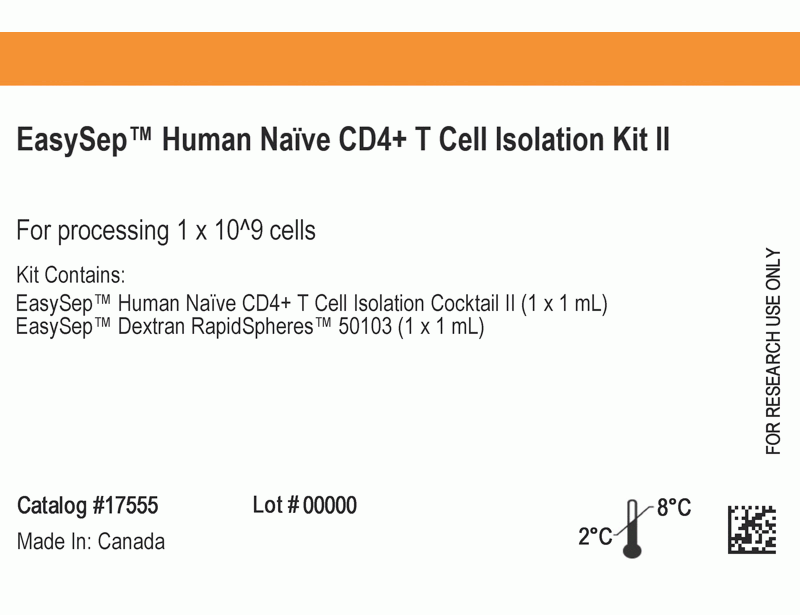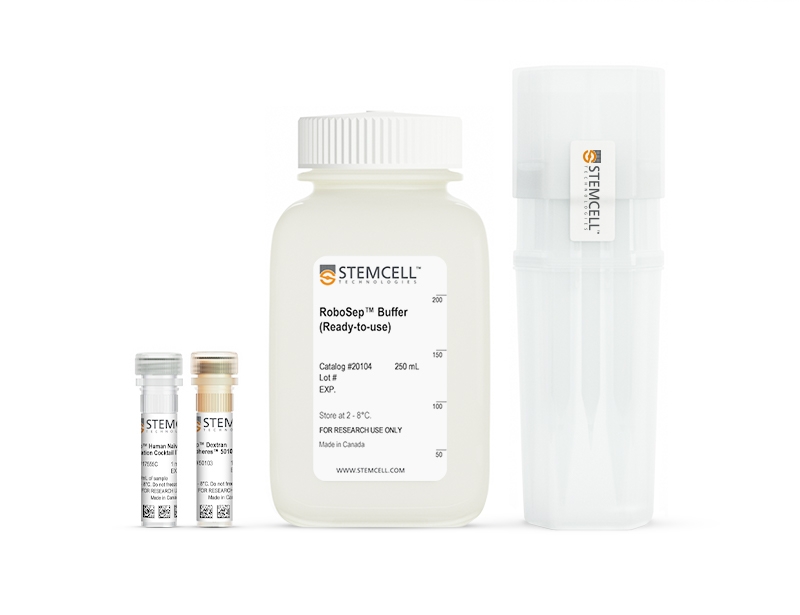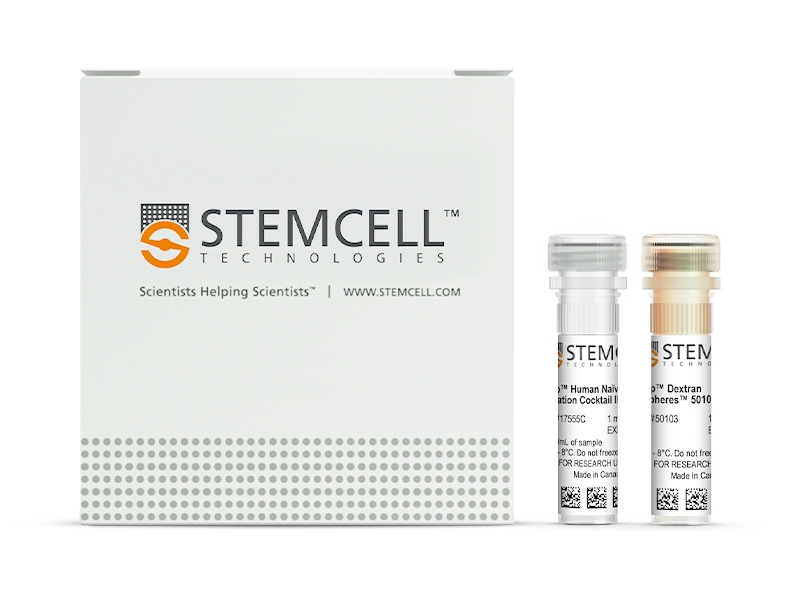EasySep™ Human Naïve CD4+ T Cell Isolation Kit II
Immunomagnetic negative selection cell isolation kit
概要
The EasySep™ Human Naïve CD4+ T Cell Isolation Kit II is designed to isolate naïve CD4+ T cells from fresh or previously frozen peripheral blood mononuclear cells by negative selection. The EasySep™ procedure involves labeling unwanted cells with antibody complexes and magnetic particles. The magnetically labeled cells are separated from the untouched desired cells by using an EasySep™ magnet and simply pouring or pipetting the desired cells into a new tube.
This kit replaces the EasySep™ Human Naïve CD4+ T Cell Enrichment Kit (Catalog #19155) and EasySep™ Human Naïve CD4+ T Cell Isolation Kit (Catalog #19555) for even faster cell isolations.
This kit replaces the EasySep™ Human Naïve CD4+ T Cell Enrichment Kit (Catalog #19155) and EasySep™ Human Naïve CD4+ T Cell Isolation Kit (Catalog #19555) for even faster cell isolations.
Advantages
• Fast, easy-to-use and column-free
• Up to 98% purity
• Untouched, viable cells
• Up to 98% purity
• Untouched, viable cells
Components
- EasySep™ Human Naïve CD4+ T Cell Isolation Kit II (Catalog #17555)
- EasySep™ Human Naïve CD4+ T Cell Isolation Cocktail II, 1 mL
- EasySep™ Dextran RapidSpheres™, 1 mL
- RoboSep™ Human Naïve CD4+ T Cell Isolation Kit II (Catalog #17555RF)
- EasySep™ Human Naïve CD4+ T Cell Isolation Cocktail II, 1 mL
- EasySep™ Dextran RapidSpheres™, 1 mL
- RoboSep™ Buffer (Catalog #20104)
- RoboSep™ Filter Tips (Catalog #20125)
Magnet Compatibility
• EasySep™ Magnet (Catalog #18000)
• “The Big Easy” EasySep™ Magnet (Catalog #18001)
• Easy 50 EasySep™ Magnet (Catalog #18002)
• EasyEights™ EasySep™ Magnet (Catalog #18103)
• RoboSep™-S (Catalog #21000)
Subtype
Cell Isolation Kits
Cell Type
T Cells, T Cells, CD4+
Species
Human
Sample Source
PBMC
Selection Method
Negative
Application
Cell Isolation
Brand
EasySep, RoboSep
Area of Interest
Immunology
技术资料
| Document Type | 产品名称 | Catalog # | Lot # | 语言 |
|---|---|---|---|---|
| Product Information Sheet | EasySep™ Human Naïve CD4+ T Cell Isolation Kit II | 17555 | All | English |
| Product Information Sheet | RoboSep™ Human Naïve CD4+ T Cell Isolation Kit II | 17555RF | All | English |
| Safety Data Sheet 1 | EasySep™ Human Naïve CD4+ T Cell Isolation Kit II | 17555 | All | English |
| Safety Data Sheet 2 | EasySep™ Human Naïve CD4+ T Cell Isolation Kit II | 17555 | All | English |
| Safety Data Sheet 3 | EasySep™ Human Naïve CD4+ T Cell Isolation Kit II | 17555 | All | English |
| Safety Data Sheet 1 | RoboSep™ Human Naïve CD4+ T Cell Isolation Kit II | 17555RF | All | English |
| Safety Data Sheet 2 | RoboSep™ Human Naïve CD4+ T Cell Isolation Kit II | 17555RF | All | English |
| Safety Data Sheet 3 | RoboSep™ Human Naïve CD4+ T Cell Isolation Kit II | 17555RF | All | English |
数据及文献
Data

Starting with fresh mononuclear cells, the naïve CD4+ T cell content (CD3+CD4+CD45RA+CD45RO-) of the isolated fraction is typically 96.6 ± 1.5% (mean ± SD using the purple EasySep™ Magnet). In the above example, the purities of the start and final isolated fractions are 13.0% and 97.3%, respectively.
Publications (1)
Cell systems 2020 mar
Gut-Liver Physiomimetics Reveal Paradoxical Modulation of IBD-Related Inflammation by Short-Chain Fatty Acids.
Abstract
Abstract
Although the association between the microbiome and IBD and liver diseases is known, the cause and effect remain elusive. By connecting human microphysiological systems of the gut, liver, and circulating Treg and Th17 cells, we created a multi-organ model of ulcerative colitis (UC) ex vivo. The approach shows microbiome-derived short-chain fatty acids (SCFAs) to either improve or worsen UC severity, depending on the involvement of effector CD4 T cells. Using multiomics, we found SCFAs increased production of ketone bodies, glycolysis, and lipogenesis, while markedly reducing innate immune activation of the UC gut. However, during acute T cell-mediated inflammation, SCFAs exacerbated CD4+ T cell-effector function, partially through metabolic reprograming, leading to gut barrier disruption and hepatic injury. These paradoxical findings underscore the emerging utility of human physiomimetic technology in combination with systems immunology to study causality and the fundamental entanglement of immunity, metabolism, and tissue homeostasis.



